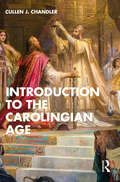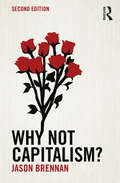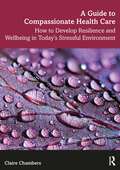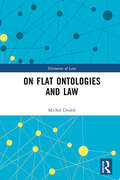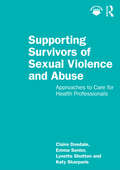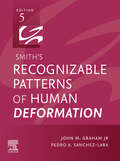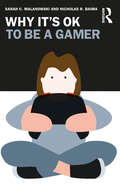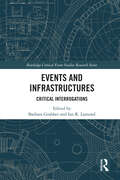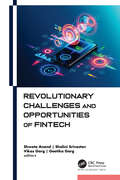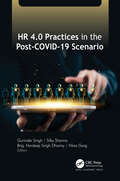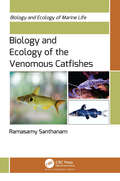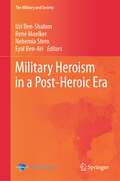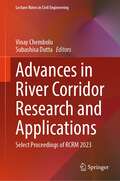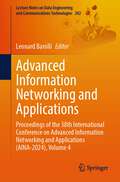- Table View
- List View
Introduction to the Carolingian Age
by Cullen J. ChandlerIntroduction to the Carolingian Age provides an accessible history of western Europe in the eighth and ninth centuries, when arguably a truly European civilization emerged out of the transformed, former world of the Roman Empire.Through a thematical and chronological approach, this book explores the life, family, and period of Charlemagne in a clear and informative way. The secular aristocrats, ecclesiastical figures, and scholars associated with the Carolingian dynasty feature as partners in building the empire and guiding its development, and the social and cultural lives of people from the elite to the common classes are also examined. Through an engaging narrative, this study demonstrates that by the end of the ninth century, the royal house faced a series of challenges that brought about the devolution of the empire into smaller kingdoms and the loosening of the Carolingian family’s grip on monarchy. Based on up-to-date scholarship, Introduction to the Carolingian Age offers explanations of historical developments and discussions of key historiographical debates.This book is an essential resource for both undergraduate students and general readers with an interest in the history of the Carolingian period from 750–900.
Why Not Capitalism?
by Jason BrennanMost people believe capitalism is a compromise with selfish human nature. As Adam Smith put it, "It is not from the benevolence of the butcher, the brewer, or the baker, that we expect our dinner, but from their regard to their own interest." Capitalism works better than socialism, according to this thinking, only because we are not kind and generous enough to make socialism work. If we were saints, we would be socialists.In Why Not Capitalism?, Jason Brennan attacks this widely held belief, arguing that capitalism would remain the best system even if we were morally perfect. Even then, private property and free markets would be the best way to realize mutual cooperation, social justice, harmony, and prosperity. Socialists seek to capture the moral high ground by showing that ideal socialism is morally superior to realistic capitalism. But, Brennan responds, ideal capitalism is superior to ideal socialism, and so capitalism beats socialism at every level.Clearly, engagingly, and at times provocatively written, Why Not Capitalism? will cause readers of all political persuasions to re-evaluate where they stand vis-à-vis economic priorities and systems—as they exist now and as they might be improved in the future.In this expanded second edition, Brennan responds to his critics throughout the book and provides two new, final chapters. One argues against egalitarianism in a capitalist utopia because egalitarianism frequently misdiagnoses the problems (for example, the problem with poverty isn’t that poor people have less but that they don’t have enough). The other new chapter shows that we don’t need to be angels in an anarchic utopia, but merely decent people who are willing to adhere to four undemanding moral principles.
The Evolution of Airport Design
by Robert StewartThis is the first book to comprehensively cover the evolution of airport design, from the start of commercial aviation in 1919 to the present day. Many books have been written about airport design at a particular moment in history, but none have rigorously considered why, where, when and how the ideas we now take for granted originated.This book traces the history of airport design considering the philosophies adopted by designers, the functional layouts they have developed and the resultant form of the airport through a series of 40 case studies divided into 7 eras of approximately 20 years each. The themes include: The philosophies underpinning airport design The evolution of design responses How airports have avoided obsolescence Identification of the key turning points The evolution of master plans and terminal concepts in response to increasing traffic volumes The future of airports in terms of environmental sustainability and the Covid-19 hiatus The case studies are international, covering the USA, Germany, the UK, France, the Netherlands, Singapore, Saudi Arabia, Japan, Hong Kong, Malaysia, South Korea, Thailand, Spain, United Arab Emirates, China, Turkey, Mexico, Australia and Poland. They are illustrated with full colour, many of which have not been published before and form part of an incredible graphic package. This book is essential reading for architects, engineers, planners and environmentalists alike.
The Evolution of Airport Design
by Robert StewartThis is the first book to comprehensively cover the evolution of airport design, from the start of commercial aviation in 1919 to the present day. Many books have been written about airport design at a particular moment in history, but none have rigorously considered why, where, when and how the ideas we now take for granted originated.This book traces the history of airport design considering the philosophies adopted by designers, the functional layouts they have developed and the resultant form of the airport through a series of 40 case studies divided into 7 eras of approximately 20 years each. The themes include: The philosophies underpinning airport design The evolution of design responses How airports have avoided obsolescence Identification of the key turning points The evolution of master plans and terminal concepts in response to increasing traffic volumes The future of airports in terms of environmental sustainability and the Covid-19 hiatus The case studies are international, covering the USA, Germany, the UK, France, the Netherlands, Singapore, Saudi Arabia, Japan, Hong Kong, Malaysia, South Korea, Thailand, Spain, United Arab Emirates, China, Turkey, Mexico, Australia and Poland. They are illustrated with full colour, many of which have not been published before and form part of an incredible graphic package. This book is essential reading for architects, engineers, planners and environmentalists alike.
A Guide to Compassionate Healthcare: How to Develop Resilience and Wellbeing in Today’s Stressful Environment
by Claire ChambersA Guide to Compassionate Healthcare looks at how to maintain wellbeing in today’s challenging healthcare environments, enabling practitioners to make a positive difference to the care environment whilst providing compassionate care to patients.This practical guide focuses on strategies to maintain health and wellbeing as health care practitioners, in relation to stress management, resilience and positivity. Health and social care practitioners have been challenged over and above anything they have faced before due to the Covid pandemic. These situations have caused extreme trauma and stress to patients, their loved ones and those who have been struggling to care for them. The book highlights why resilience and good stress management are crucial, and how they can be achieved through a focus on wellbeing and positivity, referring to her RESPECT toolkit: Resilience, Emotional intelligence, Stress management, Positivity, Energy and motivation, Challenge and Team leadership.This is essential reading for all those working in healthcare today who are passionate about compassionate care and want to ensure that they remain positive and well, particularly newly qualified staff.
A Guide to Compassionate Healthcare: How to Develop Resilience and Wellbeing in Today’s Stressful Environment
by Claire ChambersA Guide to Compassionate Healthcare looks at how to maintain wellbeing in today’s challenging healthcare environments, enabling practitioners to make a positive difference to the care environment whilst providing compassionate care to patients.This practical guide focuses on strategies to maintain health and wellbeing as health care practitioners, in relation to stress management, resilience and positivity. Health and social care practitioners have been challenged over and above anything they have faced before due to the Covid pandemic. These situations have caused extreme trauma and stress to patients, their loved ones and those who have been struggling to care for them. The book highlights why resilience and good stress management are crucial, and how they can be achieved through a focus on wellbeing and positivity, referring to her RESPECT toolkit: Resilience, Emotional intelligence, Stress management, Positivity, Energy and motivation, Challenge and Team leadership.This is essential reading for all those working in healthcare today who are passionate about compassionate care and want to ensure that they remain positive and well, particularly newly qualified staff.
On Flat Ontologies and Law (ISSN)
by Michał DudekThis book examines the importance of flat ontologies for law and sociolegal theory. Associated with the emergence of new materialism in the humanities and social sciences, the elaboration of flat ontologies challenges the binarism that has maintained the separation of culture from nature, and the human from the nonhuman. Although most work in legal theory and sociolegal studies continues to adopt a non-flat, anthropocentric and immaterial take on law, the critique of this perspective is becoming more and more influential. Engaging the increasing legal interest in flat ontologies, this book offers an account of the main theoretical perspectives, and their importance for law. Covering the work of the five major theorists in the area – Gabriel Tarde, Bruno Latour, Manuel DeLanda, Karen Barad and Graham Harman – the book aims to encourage this interest, as well as to explicate the important problems of and differences between these perspectives. Flat ontologies, the book demonstrates, can offer a valuable new perspective for understanding and thinking about law.This book will appeal mainly to scholars and students in legal theory and sociolegal studies; as well as others with interests in the posthumanist turn in philosophy and social theory.
On Flat Ontologies and Law (ISSN)
by Michał DudekThis book examines the importance of flat ontologies for law and sociolegal theory. Associated with the emergence of new materialism in the humanities and social sciences, the elaboration of flat ontologies challenges the binarism that has maintained the separation of culture from nature, and the human from the nonhuman. Although most work in legal theory and sociolegal studies continues to adopt a non-flat, anthropocentric and immaterial take on law, the critique of this perspective is becoming more and more influential. Engaging the increasing legal interest in flat ontologies, this book offers an account of the main theoretical perspectives, and their importance for law. Covering the work of the five major theorists in the area – Gabriel Tarde, Bruno Latour, Manuel DeLanda, Karen Barad and Graham Harman – the book aims to encourage this interest, as well as to explicate the important problems of and differences between these perspectives. Flat ontologies, the book demonstrates, can offer a valuable new perspective for understanding and thinking about law.This book will appeal mainly to scholars and students in legal theory and sociolegal studies; as well as others with interests in the posthumanist turn in philosophy and social theory.
Supporting Survivors of Sexual Violence and Abuse: Approaches to Care for Health Professionals
by Claire Dosdale Emma Senior Lynette Shotton Katy SkarparisThis textbook provides practical guidance to enable health professionals to support survivors of sexual violence. It gives insight into the complex and wide-ranging nature and experience of sexual violence, barriers to disclosure, and explores the implications for survivors, health professionals and healthcare organisations.An evidence-based resource, this book provides information, guidance and signposting for all those who might receive disclosures of sexual violence, challenging perceptions, stigma and judgement. As well as discussing disclosure of recent experiences, it takes into account that life events may trigger the re-surfacing of prior experiences. The book also operates as a practical tool, prompting professionals to reflect on their own clinical experience of dealing with disclosures of sexual violence. The chapters look at the full breadth of sexual violence and abuse, including rape and sexual assault, child sexual abuse, harassment and stalking, exploitation, trafficking, conflict situations, traditional practices and sexual violence in LGBTQAI+ communitites.Enabling readers to develop the necessary knowledge and understanding to inform their practice, this book is a comprehensive resource for all health professionals, across primary and secondary care. It is also a valuable text for those taking post-registration courses in sexual health, specialist community and public health nursing, district nursing, mental health and children’s nursing among others. Reflection sections can be used to support professional registration revalidation.
Supporting Survivors of Sexual Violence and Abuse: Approaches to Care for Health Professionals
by Claire Dosdale Emma Senior Lynette Shotton Katy SkarparisThis textbook provides practical guidance to enable health professionals to support survivors of sexual violence. It gives insight into the complex and wide-ranging nature and experience of sexual violence, barriers to disclosure, and explores the implications for survivors, health professionals and healthcare organisations.An evidence-based resource, this book provides information, guidance and signposting for all those who might receive disclosures of sexual violence, challenging perceptions, stigma and judgement. As well as discussing disclosure of recent experiences, it takes into account that life events may trigger the re-surfacing of prior experiences. The book also operates as a practical tool, prompting professionals to reflect on their own clinical experience of dealing with disclosures of sexual violence. The chapters look at the full breadth of sexual violence and abuse, including rape and sexual assault, child sexual abuse, harassment and stalking, exploitation, trafficking, conflict situations, traditional practices and sexual violence in LGBTQAI+ communitites.Enabling readers to develop the necessary knowledge and understanding to inform their practice, this book is a comprehensive resource for all health professionals, across primary and secondary care. It is also a valuable text for those taking post-registration courses in sexual health, specialist community and public health nursing, district nursing, mental health and children’s nursing among others. Reflection sections can be used to support professional registration revalidation.
Smith's Recognizable Patterns of Human Deformation E-Book
by John M. Graham Pedro A. Sanchez-LaraThe only reference devoted to the diagnoses and management of birth defects resulting from mechanical forces, Smith's Recognizable Patterns of Human Deformation, 5th Edition, provides evidence-based management for a range of common pediatric problems affecting the limbs and craniofacial region. Continuing the tradition of excellence established by Dr. Smith’s research and teaching, this title supplies highly readable, well-illustrated guidance needed for timely intervention and effective treatment in order to avoid long-term adverse secondary consequences. It’s an ideal resource offering comprehensive, systematic coverage for residents, pediatricians, practitioners, or parents seeking further information in this complex area.Examines the initial clinical approach to suspected deformation problems, and then walks you through pathogenesis, diagnostic features, management, prognosis, and counseling for each condition.Addresses a full range of lower extremity deformations; joint dislocations; nerve palsies; chest and spinal deformations; head and neck deformations; craniosynostosis and cranial bone variations; problems associated with abnormal birth presentation, birth palsies, and procedure-related defects; infant head shape variations; and torticollis.Includes new chapters on early embryonic disruption and fetal disruption, new Key Points boxes throughout, new insights and references in every chapter, and a new video on the physical examination of a patient with a congenital radial nerve palsy.Distinguishes deformations from malformations for appropriate management.Utilizes four consistent sections in every chapter—Genesis, Features, Management and Prognosis, and Differential Diagnosis—to provide concise yet comprehensive information on 50 common pediatric conditions.Provides evidence-based management recommendations on common fetal complications such as oligohydramnios, pulmonary hypoplasia, and uterine structural abnormalities, and discusses current management techniques for each.Offers essential information to a range of professionals, including neonatologists, pediatricians, family practitioners, nurses, physical and occupational therapists, rehabilitative specialists, pediatric nurse practitioners, and residents in all fields.Any additional digital ancillary content may publish up to 6 weeks following the publication date.
Why It's OK to Be a Gamer (Why It's OK)
by Sarah C. Malanowski Nicholas R. BaimaIf you enjoy video games as a pastime, you are certainly not alone—billions of people worldwide now play video games. However, you may still find yourself reluctant to tell others this fact about yourself. After all, we are routinely warned that video games have the potential to cause addiction and violence. And when we aren’t being warned of their outright harms, we are told we should be doing something better with our time, like going outside, socializing with others, or reading a book. Playing video games is thus often seen at best as a waste of time, and at worst a source of violent tragedy.Why It’s OK to Be a Gamer takes on the pervasive assumption that playing video games is a childish and time-wasting hobby, and a potentially addictive and dangerous one at that. It argues instead that there are many ways in which gaming can help us flourish, for example by: developing genuine friendships and other meaningful relationships with others, helping us cultivate a virtuous personal character, giving us a unique aesthetic experience, providing us with psychological benefits, and just plain helping us relax and enjoy ourselves. Video games are not just for those with no life; on the contrary, they can help contribute to a rich and meaningful life.Key Features Introduces the philosophy of video games in a humorous and lively way with lots of engaging examples Defends gaming through a virtue theoretic approach Discusses contemporary psychology and neuroscience literature on gaming Includes discussion of gamers, video games, and common experiences of gaming
Why It's OK to Be a Gamer (Why It's OK)
by Sarah C. Malanowski Nicholas R. BaimaIf you enjoy video games as a pastime, you are certainly not alone—billions of people worldwide now play video games. However, you may still find yourself reluctant to tell others this fact about yourself. After all, we are routinely warned that video games have the potential to cause addiction and violence. And when we aren’t being warned of their outright harms, we are told we should be doing something better with our time, like going outside, socializing with others, or reading a book. Playing video games is thus often seen at best as a waste of time, and at worst a source of violent tragedy.Why It’s OK to Be a Gamer takes on the pervasive assumption that playing video games is a childish and time-wasting hobby, and a potentially addictive and dangerous one at that. It argues instead that there are many ways in which gaming can help us flourish, for example by: developing genuine friendships and other meaningful relationships with others, helping us cultivate a virtuous personal character, giving us a unique aesthetic experience, providing us with psychological benefits, and just plain helping us relax and enjoy ourselves. Video games are not just for those with no life; on the contrary, they can help contribute to a rich and meaningful life.Key Features Introduces the philosophy of video games in a humorous and lively way with lots of engaging examples Defends gaming through a virtue theoretic approach Discusses contemporary psychology and neuroscience literature on gaming Includes discussion of gamers, video games, and common experiences of gaming
Events and Infrastructures: Critical Interrogations (ISSN)
Innovative and the first of its kind, this informative and multidisciplinary book explores the socio-cultural significance inherent in event infrastructures.While mainstream event management literature addresses event infrastructures mainly through its operational relevance, this carefully compiled edited volume takes infrastructures as an analytical point in respect to its social, political, economic and cultural potential of the study of events. Borrowing from the ongoing social scientific debates on the geography, sociology and anthropology of infrastructures, critical questions are posed in relation to the event contexts. With references to events in Argentina, Malawi, Spain and the UK, among others, the volume combines an international perspective with a highly relevant subject for contemporary event management education.By bringing together theoretical as well as empirical readings on the question of event infrastructures from a critical point of view, the debates are relevant to practitioners and researchers as well as undergraduate and postgraduate students in the field of events, leisure, tourism, anthropology, sociology, geography and urban planning – among others.
Events and Infrastructures: Critical Interrogations (ISSN)
by Barbara Grabher Ian R. LamondInnovative and the first of its kind, this informative and multidisciplinary book explores the socio-cultural significance inherent in event infrastructures.While mainstream event management literature addresses event infrastructures mainly through its operational relevance, this carefully compiled edited volume takes infrastructures as an analytical point in respect to its social, political, economic and cultural potential of the study of events. Borrowing from the ongoing social scientific debates on the geography, sociology and anthropology of infrastructures, critical questions are posed in relation to the event contexts. With references to events in Argentina, Malawi, Spain and the UK, among others, the volume combines an international perspective with a highly relevant subject for contemporary event management education.By bringing together theoretical as well as empirical readings on the question of event infrastructures from a critical point of view, the debates are relevant to practitioners and researchers as well as undergraduate and postgraduate students in the field of events, leisure, tourism, anthropology, sociology, geography and urban planning – among others.
Revolutionary Challenges and Opportunities of Fintech
by Shweta Anand Shalini Srivastav Vikas Garg Geetika GargThis book explores the emergence of artificial intelligence blended with financial concepts as a promising new area in business and technology—financial technology, or fintech.The book introduces the very relevant concepts of fintech, its financial derivatives, management information systems, and artificial intelligence and provides tools to find solutions to complex problems in the finance and investment domain. The case studies provide firsthand knowledge of real problems faced by the industry and highlights the thought processes in resolution of complex problems.Topics address the global adoption of fintech, fintech disruptions in the financial sector, the use of machine learning and artificial intelligence to increase the effectiveness of financial trading algorithms, fintech in retail banking and risk management, inbound marketing as well as internal marketing for fintech, fintech in the international education sector, and more.Both business professionals and those in the technical industry will find this book to be of great use. It will be quite helpful for both professionals and students in the fields of finance and artificial intelligence.
Revolutionary Challenges and Opportunities of Fintech
This book explores the emergence of artificial intelligence blended with financial concepts as a promising new area in business and technology—financial technology, or fintech.The book introduces the very relevant concepts of fintech, its financial derivatives, management information systems, and artificial intelligence and provides tools to find solutions to complex problems in the finance and investment domain. The case studies provide firsthand knowledge of real problems faced by the industry and highlights the thought processes in resolution of complex problems.Topics address the global adoption of fintech, fintech disruptions in the financial sector, the use of machine learning and artificial intelligence to increase the effectiveness of financial trading algorithms, fintech in retail banking and risk management, inbound marketing as well as internal marketing for fintech, fintech in the international education sector, and more.Both business professionals and those in the technical industry will find this book to be of great use. It will be quite helpful for both professionals and students in the fields of finance and artificial intelligence.
HR 4.0 Practices in the Post-COVID-19 Scenario
This new volume examines the dramatic impact of the COVID-19 pandemic and its embrace of the digital revolution on human resources management practices, providing a better understanding of the emerging role of HR 4.0 and equipping HR professionals with the knowledge they need to chart plausible future organizational directions. The book will familiarize readers with the most relevant and latest concepts of HR 4.0 practices, providing tools for solutions to complex problems in managing a multigenerational workforce in this volatile, uncertain, complex, and ambiguous (VUCA) world. The chapter authors discuss an array of topics, including the work-from-home transition, digitization of the workforce, employee work-life balance, task automation technologies via AI, HRM curriculum at schools and universities, employee development, e-recruitment, internal marketing, and more.
HR 4.0 Practices in the Post-COVID-19 Scenario
by Gurinder Singh Silky Sharma Brig. Hardeep Singh Dhanny Vikas GargThis new volume examines the dramatic impact of the COVID-19 pandemic and its embrace of the digital revolution on human resources management practices, providing a better understanding of the emerging role of HR 4.0 and equipping HR professionals with the knowledge they need to chart plausible future organizational directions. The book will familiarize readers with the most relevant and latest concepts of HR 4.0 practices, providing tools for solutions to complex problems in managing a multigenerational workforce in this volatile, uncertain, complex, and ambiguous (VUCA) world. The chapter authors discuss an array of topics, including the work-from-home transition, digitization of the workforce, employee work-life balance, task automation technologies via AI, HRM curriculum at schools and universities, employee development, e-recruitment, internal marketing, and more.
Biology and Ecology of the Venomous Catfishes (Biology and Ecology of Marine Life)
by Ramasamy SanthanamHere is a first-of-its-kind volume on the biology and ecology of venomous and traumatogenic freshwater and marine catfishes. This comprehensive volume first provides an introduction to venomous catfish families and then goes on to describe and explain their diversity, species, characteristics, geographical distribution, venomous symptoms, ecology, and the pharmaceutical value of catfish venoms.Catfish form an important group of fishes with many different roles, including as food, as ornamental fishes, and for sport fishing. Catfish are found to be distributed worldwide but are most abundantly distributed in the tropics of Asia, Africa, and South America. Like jellyfish, scorpions, and snakes, several species of catfish have been reported to be venomous with their painful stings. The major groups of persons at risk for catfish envenomation are fishermen and water sports participants. It is estimated that 1625 species of catfish are venomous although this has been studied for only 158 species. While some species of catfish cause mild envenomation, several species have been reported to cause severe envenomation associated with secondary bacterial infections. The symptoms related to catfish envenomation include local intense pain, edema, erythema, paleness, and cutaneous necrosis. Notable species of catfish causing serious envenomations include the Arabian Gulf catfish (Arius thalassinus), Carolina madtom (Noturus furiosus), and Oriental catfish (Plotosus lineatus).Providing extensive information, this volume serves as a text and reference for students and researchers of several disciplines, such as marine biology, fisheries science, and aquatic biology; as a guide for physicians and environmentalists; and as a valuable reference book for marine libraries of colleges and universities.
Biology and Ecology of the Venomous Catfishes (Biology and Ecology of Marine Life)
by Ramasamy SanthanamHere is a first-of-its-kind volume on the biology and ecology of venomous and traumatogenic freshwater and marine catfishes. This comprehensive volume first provides an introduction to venomous catfish families and then goes on to describe and explain their diversity, species, characteristics, geographical distribution, venomous symptoms, ecology, and the pharmaceutical value of catfish venoms.Catfish form an important group of fishes with many different roles, including as food, as ornamental fishes, and for sport fishing. Catfish are found to be distributed worldwide but are most abundantly distributed in the tropics of Asia, Africa, and South America. Like jellyfish, scorpions, and snakes, several species of catfish have been reported to be venomous with their painful stings. The major groups of persons at risk for catfish envenomation are fishermen and water sports participants. It is estimated that 1625 species of catfish are venomous although this has been studied for only 158 species. While some species of catfish cause mild envenomation, several species have been reported to cause severe envenomation associated with secondary bacterial infections. The symptoms related to catfish envenomation include local intense pain, edema, erythema, paleness, and cutaneous necrosis. Notable species of catfish causing serious envenomations include the Arabian Gulf catfish (Arius thalassinus), Carolina madtom (Noturus furiosus), and Oriental catfish (Plotosus lineatus).Providing extensive information, this volume serves as a text and reference for students and researchers of several disciplines, such as marine biology, fisheries science, and aquatic biology; as a guide for physicians and environmentalists; and as a valuable reference book for marine libraries of colleges and universities.
Military Heroism in a Post-Heroic Era (The Military and Society)
by Uzi Ben-Shalom René Moelker Nehemia Stern Eyal Ben-AriThis book explores the variety of forms that individual heroism and sacrifice can take in the context of contemporary military conflicts. It addresses three key questions: How has an enduring ideal of heroism been transformed by the nature of modern warfare? Are we now witnessing the emergence of new forms of exemplary military behavior? And, have new ideals of heroism (and by association, sacrifice or bravery) been added to older forms in the recent past? The book advocates viewing the concept of military heroism as a moral category, in which its theoretical definition and empirical practice reflect those factors that are seen as being vital for society itself. The key theoretical and topical challenges addressed in the respective chapters focus on how ideas of heroism become entwined with issues of individualization (bolstered by the cultural assumptions of neo-Liberalism), the spread of the human rights discourse, and the judicialization, marketization and mediatization of armedforces. The book was written by experts on military studies, including many who are currently active military personnel. It includes contributions from a variety of disciplines, e.g. anthropology, sociology, psychology, and political science.
Ehrenamtliche Bürgermeister in Deutschland: Das unbekannte Wesen (Stadtforschung aktuell)
by Jörg Bogumil David H. Gehne Louisa Anna SüßDieses open access Buch enthält als erste politikwissenschaftliche Publikation Daten zu ehrenamtlichen Bürgermeistern für alle 10 Bundesländer, in denen diese eine wichtige Position der politischen Repräsentation in ländlichen Räumen einnehmen. Etwa 60% aller Kommunen in Deutschland werden von ehrenamtlichen Bürgermeistern verwaltet, deren regionale Bedeutung sich je nach Bundesland aber stark unterscheidet. Das Buch leitet mit der Beschreibung des jeweiligen rechtlichen Rahmens der Kommunalverfassungen der Bundesländer, der regionalen Verteilung und der Analyse von Wahldaten in das Thema der ehrenamtlichen Bürgermeister ein, bevor die Ergebnisse eines breit angelegten repräsentativen Umfrageprojektes präsentiert werden. Mit diesen verschiedenen Forschungsansätzen leistet das Buch einen Beitrag zur Forschungsliteratur sowohl der lokalen Politikforschung zu Bürgermeistern als auch zum Ehrenamt in ländlichen Räumen. Erstmalig können in diesem Ausmaß Daten über die Sozialstruktur, Aufgaben, Motivation, Amtsausführung, Beziehung zu Partei oder Wählergemeinschaft, Vereinbarkeit von Beruf, Familie und Ehrenamt, Anfeindungen sowie potenziellem Nachwuchs im Ehrenamt als Bürgermeister präsentiert werden. Trotz unterschiedlicher rechtlicher Rahmensetzungen der Bundesländer zeigen sich ähnliche Probleme und Herausforderungen für deren Lösung.
Advances in River Corridor Research and Applications: Select Proceedings of RCRM 2023 (Lecture Notes in Civil Engineering #470)
by Vinay Chembolu Subashisa DuttaThis book presents the select proceedings of the 3rd International Conference on River Corridor Research and Management (RCRM 2023). It describes various topics on fluvio-hydro-ecological processes of river systems. The topics covered include river dynamics and morphological changes, river health and ecological aspects and satellite remote sensing for river corridor studies. The book also discusses the morphological behavior of gravel and sand-bed rivers, hydrological and hydraulics modeling and other important aspects of riverine ecology. The book will be a valuable reference for researchers and professionals working in the areas of river science.
Advanced Information Networking and Applications: Proceedings of the 38th International Conference on Advanced Information Networking and Applications (AINA-2024), Volume 4 (Lecture Notes on Data Engineering and Communications Technologies #202)
by Leonard BarolliThe aim of the book is to provide latest research findings, innovative research results, methods, and development techniques from both theoretical and practical perspectives related to the emerging areas of information networking and applications. Networks of today are going through a rapid evolution, and there are many emerging areas of information networking and their applications. Heterogeneous networking supported by recent technological advances in low power wireless communications along with silicon integration of various functionalities such as sensing, communications, intelligence, and actuations is emerging as a critically important disruptive computer class based on a new platform, networking structure, and interface that enable novel, low-cost and high-volume applications. Several of such applications have been difficult to realize because of many interconnection problems. To fulfill their large range of applications different kinds of networks need to collaborate and wired and next-generation wireless systems should be integrated in order to develop high-performance computing solutions to problems arising from the complexities of these networks. This book covers the theory, design, and applications of computer networks, distributed computing, and information systems.
